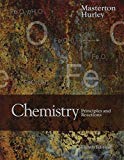
Bundle: Chemistry: Principles and Reactions, 8th, Loose-Leaf + OWLv2, 1 term (6 months) Printed Access Card
8th Edition
ISBN: 9781305717497
Author: William L. Masterton, Cecile N. Hurley
Publisher: Cengage Learning
expand_more
expand_more
format_list_bulleted
Concept explainers
Question
Chapter 23, Problem 20QAP
Interpretation Introduction
Interpretation:
The structure of the disaccharide formed by two alpha mannose needs to be determined.
Concept introduction:
Mannose is a type of sugar having the molecular formula C6 H12 O6 . It is also known as aldohexose consisting of 6 carbon atoms. It consists of hydroxyl moiety and based on the arrangement of hydroxyl group, the alpha and beta anomer of mannose are decided
Expert Solution & Answer
Want to see the full answer?
Check out a sample textbook solution
Students have asked these similar questions
>
You are trying to decide if there is a single reagent you can add that will make the following synthesis possible without any other
major side products:
1. ☑
CI
2. H3O+
O
Draw the missing reagent X you think will make this synthesis work in the drawing area below.
If there is no reagent that will make your desired product in good yield or without complications, just check the box under the
drawing area and leave it blank.
Click and drag to start drawing a
structure.
Explanation
Check
?
DO
18
Ar
B
© 2025 McGraw Hill LLC. All Rights Reserved. Terms of Use | Privacy Center | Accessibility
Don't use ai to answer I will report you answer
Consider a solution of 0.00304 moles of 4-nitrobenzoic acid (pKa = 3.442) dissolved in 25 mL water and titrated with 0.0991 M NaOH. Calculate the pH at the equivalence point
Chapter 23 Solutions
Bundle: Chemistry: Principles and Reactions, 8th, Loose-Leaf + OWLv2, 1 term (6 months) Printed Access Card
Ch. 23 - Prob. 1QAPCh. 23 - Prob. 2QAPCh. 23 - Prob. 3QAPCh. 23 - Prob. 4QAPCh. 23 - Prob. 5QAPCh. 23 - Prob. 6QAPCh. 23 - Prob. 7QAPCh. 23 - Prob. 8QAPCh. 23 - Prob. 9QAPCh. 23 - Prob. 10QAP
Ch. 23 - Prob. 11QAPCh. 23 - Prob. 12QAPCh. 23 - Prob. 13QAPCh. 23 - Prob. 14QAPCh. 23 - Prob. 15QAPCh. 23 - Prob. 16QAPCh. 23 - Prob. 17QAPCh. 23 - Prob. 18QAPCh. 23 - Prob. 19QAPCh. 23 - Prob. 20QAPCh. 23 - How many chiral carbon atoms are there in ...Ch. 23 - How many chiral carbon atoms are there in sucrose?...Ch. 23 - Prob. 23QAPCh. 23 - Give the structural formulas of two different...Ch. 23 - (a) How many tripeptides can be made from glycine,...Ch. 23 - Prob. 26QAPCh. 23 - Prob. 27QAPCh. 23 - Prob. 28QAPCh. 23 - For alanine, Ka1=5.1105,Ka2=1.81010 . Calculate...Ch. 23 - Prob. 30QAPCh. 23 - On complete hydrolysis, a polypeptide gives two...Ch. 23 - Prob. 32QAPCh. 23 - Prob. 33QAPCh. 23 - Prob. 34QAPCh. 23 - Prob. 35QAPCh. 23 - Prob. 36QAPCh. 23 - Prob. 37QAPCh. 23 - Prob. 38QAPCh. 23 - Prob. 39QAPCh. 23 - Prob. 40QAPCh. 23 - Prob. 41QAPCh. 23 - Sketch the form in which leucine would exist in...Ch. 23 - How many tripeptides could one make from glycine,...Ch. 23 - A 1.00-mg sample of a pure protein yielded on...Ch. 23 - Describe what is meant by (a) the primary...Ch. 23 - Glycolysis is the process by which glucose is...Ch. 23 - Plants synthesize carbohydrates from CO2 and H2O...Ch. 23 - Prob. 48QAPCh. 23 - Prob. 49QAPCh. 23 - Prob. 50QAPCh. 23 - Prob. 51QAPCh. 23 - Aspartic acid acts as a triprotic acid with...
Knowledge Booster
Learn more about
Need a deep-dive on the concept behind this application? Look no further. Learn more about this topic, chemistry and related others by exploring similar questions and additional content below.Similar questions
- What is the name of the following compound? SiMe3arrow_forwardK Draw the starting structure that would lead to the major product shown under the provided conditions. Drawing 1. NaNH2 2. PhCH2Br 4 57°F Sunny Q Searcharrow_forward7 Draw the starting alkyl bromide that would produce this alkyne under these conditions. F Drawing 1. NaNH2, A 2. H3O+ £ 4 Temps to rise Tomorrow Q Search H2arrow_forward
arrow_back_ios
SEE MORE QUESTIONS
arrow_forward_ios
Recommended textbooks for you
 Chemistry: Principles and ReactionsChemistryISBN:9781305079373Author:William L. Masterton, Cecile N. HurleyPublisher:Cengage Learning
Chemistry: Principles and ReactionsChemistryISBN:9781305079373Author:William L. Masterton, Cecile N. HurleyPublisher:Cengage Learning Introduction to General, Organic and BiochemistryChemistryISBN:9781285869759Author:Frederick A. Bettelheim, William H. Brown, Mary K. Campbell, Shawn O. Farrell, Omar TorresPublisher:Cengage Learning
Introduction to General, Organic and BiochemistryChemistryISBN:9781285869759Author:Frederick A. Bettelheim, William H. Brown, Mary K. Campbell, Shawn O. Farrell, Omar TorresPublisher:Cengage Learning Introductory Chemistry: An Active Learning Approa...ChemistryISBN:9781305079250Author:Mark S. Cracolice, Ed PetersPublisher:Cengage Learning
Introductory Chemistry: An Active Learning Approa...ChemistryISBN:9781305079250Author:Mark S. Cracolice, Ed PetersPublisher:Cengage Learning- Chemistry: Matter and ChangeChemistryISBN:9780078746376Author:Dinah Zike, Laurel Dingrando, Nicholas Hainen, Cheryl WistromPublisher:Glencoe/McGraw-Hill School Pub Co
 Chemistry for Today: General, Organic, and Bioche...ChemistryISBN:9781305960060Author:Spencer L. Seager, Michael R. Slabaugh, Maren S. HansenPublisher:Cengage Learning
Chemistry for Today: General, Organic, and Bioche...ChemistryISBN:9781305960060Author:Spencer L. Seager, Michael R. Slabaugh, Maren S. HansenPublisher:Cengage Learning General, Organic, and Biological ChemistryChemistryISBN:9781285853918Author:H. Stephen StokerPublisher:Cengage Learning
General, Organic, and Biological ChemistryChemistryISBN:9781285853918Author:H. Stephen StokerPublisher:Cengage Learning

Chemistry: Principles and Reactions
Chemistry
ISBN:9781305079373
Author:William L. Masterton, Cecile N. Hurley
Publisher:Cengage Learning

Introduction to General, Organic and Biochemistry
Chemistry
ISBN:9781285869759
Author:Frederick A. Bettelheim, William H. Brown, Mary K. Campbell, Shawn O. Farrell, Omar Torres
Publisher:Cengage Learning

Introductory Chemistry: An Active Learning Approa...
Chemistry
ISBN:9781305079250
Author:Mark S. Cracolice, Ed Peters
Publisher:Cengage Learning

Chemistry: Matter and Change
Chemistry
ISBN:9780078746376
Author:Dinah Zike, Laurel Dingrando, Nicholas Hainen, Cheryl Wistrom
Publisher:Glencoe/McGraw-Hill School Pub Co

Chemistry for Today: General, Organic, and Bioche...
Chemistry
ISBN:9781305960060
Author:Spencer L. Seager, Michael R. Slabaugh, Maren S. Hansen
Publisher:Cengage Learning

General, Organic, and Biological Chemistry
Chemistry
ISBN:9781285853918
Author:H. Stephen Stoker
Publisher:Cengage Learning